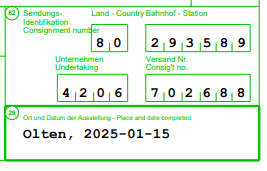1/25
How is the unique sending identifier in the CIM consignment note established?
As carriage documents progressively go digital, consignment identification is becoming an increasingly relevant issue. Under Article 6 § 3 CIM, “The consignment note shall be signed by the consignor and the carrier. The signature can be replaced by a stamp, by an accounting machine entry or in any other appropriate manner.” The solution found and implemented for the CIM consignment note at CIT level was the sending identification number. This is a combination of digits comprising the country code + station code + carrier code at departure + consignment number in accordance with field 62 of the CIM consignment note (GLV-CIM) and is included in the CIM consignment note matrix (see below).
The consignment number is a 5-position number followed by a check digit. The check digit is calculated using a Luhn algorithm. To obtain this, each digit in the consignment number is alternately multiplied by 2 or 1, reading from left to right. This gives the checksum. The difference between the checksum and the next-highest multiple of 10 gives the check digit.
Example: the consignment note number is 70268. The checksum is calculated using the values of each digit, as follows: 7 x 2 = 14 which becomes 1 and 4 for checksum purposes through to 8 x 2 = 16 which becomes 1 and 6 for checksum purposes. Checksum calculation: 1 + 4 + 0 + 4 + 6 + 1 + 6 = 22. The next-highest multiple of 10 is 30. The check digit is thus 30 – 22 = 8 as shown in the screenshot above.
This system generates a practical and secure URL (Uniform Resource Locator) number meeting the needs of rail freight carriers in cross-border freight traffic without the need for costly electronic signature processes which have also proven unsuited for banking documents.

